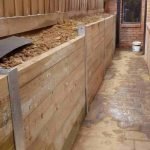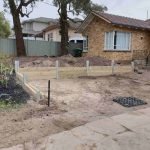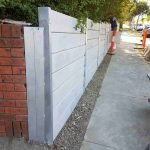Introduction
When it comes to landscaping and building and construction, one of the most vital elements to consider is the kind of soil on your property. Understanding soil types with your retaining wall installer's help can make a considerable distinction in ensuring the stability and longevity of your retaining wall. Maintaining walls serve not just as visual improvements however also play an essential role in managing soil erosion and offering support in sloped areas. This guide will dive deep into the intricacies of soil types, their attributes, and how they interact with different products like timber sleepers, concrete sleepers, and H beams
Understanding Soil Types with Your Retaining Wall Installer's Help
What Are Soil Types?
Soil types are categorized based on their physical and chemical properties. They can be broadly categorized into sandy, clayey, silty, loamy, and peaty soils. Each type has its own unique characteristics that affect drain, compaction, and overall stability.
Why Is Soil Type Crucial for Keeping Walls?
The kind of soil straight affects the style and setup of retaining walls:

- Drainage: Some soils maintain water while others enable it to drain pipes quickly. Weight: Various soil types have differing weights that can exert pressures on the retaining wall. Erosion: The susceptibility to disintegration differs with each soil type.
Common Soil Types Explained
Sandy Soil
Sandy soil includes big particles that produce big areas in between them. It drains quickly however might not hold nutrients well.
Pros:
- Excellent drainage Easy to work with
Cons:
- Low nutrient retention Susceptible to erosion
Clayey Soil
Clayey soil includes really great particles that are tightly packed together. It retains water however drains poorly.
Pros:
- High nutrient retention Good for certain plant growth
Cons:
- Poor drainage Can broaden or shrink drastically with wetness changes
Silty Soil
Silty soil is comprised of medium-sized particles that are smooth to the touch. It holds moisture better than sandy soil however drains poorly.
Pros:

- Good nutrient retention Holds moisture well
Cons:
- Compacts easily Susceptible to erosion when wet
Loamy Soil
Loamy soil is a mixture of sand, silt, and clay. It is frequently thought about the perfect garden soil due to its balance of drainage and nutrient retention.
Pros:
- Excellent drain Nutrient-rich
Cons:
- Can be expensive if purchased
Peaty Soil
Peaty soil includes a great deal of organic matter, making it dark in color. It's generally found in wet areas.
Pros:
- Rich in nutrients Great for particular plants
Cons:
- Poor drainage Can be acidic
Choosing the Right Material for Your Retaining Wall
Timber Sleepers vs. Concrete Sleepers
When building a retaining wall, you have a couple of material alternatives - timber sleepers or concrete sleepers Each has its advantages depending upon your specific needs.
Timber Sleepers
Timber sleepers use a natural look that blends well with gardens.
Advantages:
Aesthetic appeal. Easier to manage throughout installation. Cost-effective option.Disadvantages:
Prone to rot over time. May need more maintenance.Concrete Sleepers
Concrete sleepers offer durability and strength for larger walls or walls developed on unsteady soil conditions.
Advantages:
Long-lasting. Requires less maintenance. Suitable for different designs.Disadvantages:
More expensive than timber. Heavier, needing more labor during installation.H Beams as Structural Support
For vertical loads or extra structural support in your retaining wall system, using H beams can be beneficial.
Benefits of H Beams:
Provide additional strength versus lateral earth pressure. Ideal for high slopes where extra reinforcement is necessary. Versatile usage in combination with both lumber or concrete systems.Soil Analysis Before Installation
Why Conduct a Soil Test?
Conducting a soil test before installing your retaining wall is essential due to the fact that it assists identify:
Soil composition (sand, silt, clay). pH levels affecting plant growth. Drainage capabilities which impact wall design.How to Conduct a Soil Test?
You can either employ experts or do it yourself:

The Role of Your Retaining Wall Installer
Choosing a Professional Installer
Hiring a professional installer ensures that all aspects-- from soil testing to wall building and construction-- are managed expertly.
What Makes an Installer 'Professional'?
Experience in various kinds of setups (timber sleeper vs concrete sleeper). Knowledgeable about local policies and building codes. Strong portfolio showcasing previous projects.Questions to Ask Your Installer
Before devoting:
What is your experience with different soil types? Can you provide references? What products do you recommend based on my specific situation?Design Factors to consider Based upon Soil Type
Factors Influencing Design Choices
When creating your retaining wall, consider these elements based upon your specific soil type:
1. Height & & Load Bearing Capacity
Taller walls need tougher products like concrete sleepers or H beams for structural stability in clayey soils prone to expansion under moisture changes.
2. Drainage Solutions
Including perforated pipelines behind the wall can help handle water pooling behind walls built on sandy soils where quick drain is possible however requires cautious planning around stability concerns linked with heavy rains impacting fertile soils too!
Construction Process Overview
Steps Associated with Building a Keeping Wall
Building any sort of retaining wall includes numerous steps:
1. Initial Consultation
Discuss goals & & issues relating to landscape functions needing assistance along with chosen styles/materials such as timber/concrete options offered within budget constraints!
2. Site Preparation
Clear location & & guarantee proper grading towards drain outlets; mark out boundaries precisely before digging begins!
3. Foundation Laying
A solid foundation supports long-lasting performance-- https://telegra.ph/Choosing-In-Between-Various-Types-of-Retaining-Walls-with-Expert-Contractors-in-Melbourne-02-26 especially essential when using much heavier products like H beams!
4. Wall Construction
Install chosen material (timber/concrete) according to develop requirements; consist of essential supports if needed!
5. Final Touches
Include any complements wanted-- like caps atop concrete walls! Do not forget landscaping around base either!
FAQs about Maintaining Walls and Soil Types
Q1: How do I know what kind of soil I have?
A1: A professional service can perform an in-depth analysis; additionally, DIY sets are offered online for basic testing!
Q2: Can I install my own keeping wall?
A2: While possible if experienced enough-- working with professionals often saves headaches later down road by making sure everything meets local codes!
Q3: The length of time will my retaining wall last?
A3: Depends heavily on materials utilized; wood might last 10-- twenty years while concrete could last over 50 years if appropriately maintained!
Q4: What happens if my wall collapses?
A4: Routine inspections assist recognize early warning signs before collapse occurs; speak with engineers immediately upon seeing any shifts/sinking!
Q5: Is greenery helpful near retaining walls?
A5: Yes! Particular plants can stabilize surrounding earth while likewise improving visual appeals but need to pick sensibly based upon root depth & & spreading tendencies!
Q6: Do I need authorizations before building?
A6: Often yes-- but examine local policies initially because requirements differ commonly across municipalities concerning height/location restrictions etc!
Conclusion
In summary, comprehending different aspects associated specifically towards "Understanding Soil Types With Your Retaining Wall Installer's Assistance" plays an important function when launching this journey! From knowing how different products carry out versus distinct ground conditions through examining underlying earth structure prior engaging specialists-- each element contributes towards accomplishing successful outcomes! Eventually investing time in advance settles down roadway yielding aesthetically pleasing yet structurally sound solutions tailored specifically according respective site obstacles experienced throughout procedure ahead!